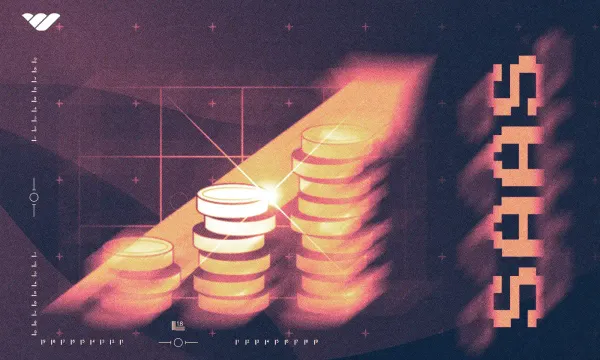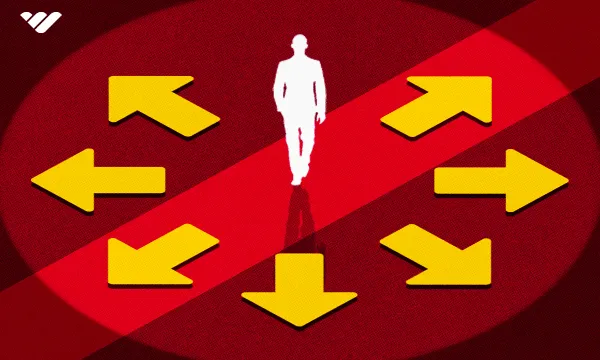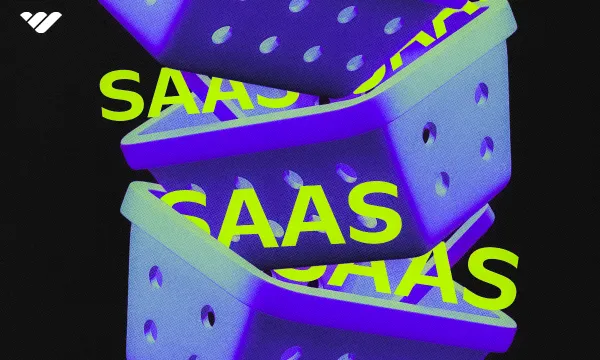The holy grail of all business models is software that generates recurring revenue. A SaaS subscription business model is perhaps the only structure that will reach this benchmark. This revenue model is appealing to both buyers and sellers.
Keep reading to understand exactly what the SaaS subscription revenue model is, what benefits it brings, and, if you’re skilled enough, how you can get started today - even if you’re not an expert coder.
SaaS Explained 💡
Let's start with the basics. SaaS is software as a service. This is the most common way that businesses choose to package and sell their software
With SaaS, rather than having to code up a custom solution for each customer like one might have to do in B2B enterprise-level software solutions, you develop your SaaS in a way that can be broadly consumed by its audience.
SaaS is centralized and typically in the cloud so that all users can simultaneously benefit from live updates. These sometimes happen automatically, without needing to download a new version as native or locally installed software requires.
Different SaaS Business Models
While some SaaS business models only have one product choice, it is more often the case that the business model will include several offerings at different price points. This generally includes a free version, a light version, a premium version, and something in between.
The business model will depend largely on how you want to price and sell your software. Ideally, the model will include a regular subscription as its main offering, the most common recurring basis being monthly or yearly.
Benefits of a SaaS Subscription:
Apart from server and development costs – the latter of which can be reduced to nothing but time if you are a solopreneur developer – creating a SaaS can be fairly cheap. So, once you have gone through the building process, you can reap your rewards!
Just about every SaaS company has a subscription revenue model for a number of reasons:
- Recurring revenue from a customer base can have increasing loyalty and thus lifetime value
- Easily scalable (in terms of fulfillment)
- Because of good profit margins past a certain level of traction, SaaS is attractive for investors, meaning you can receive money whether you want to raise to scale or sell
- SaaS subscription businesses sell at multiples that are higher than the industry average because of the recurring revenue and higher lifetime value of a customer–this can be seen on public markets where SaaS sells at an industry average of up to 6x their annual recurring revenue vs a standard 2.5-3x for ecommerce businesses. This valuation advantage is also the case on private marketplaces like Empire Flippers where SaaS-focused businesses are similarly more valued compared to their ecommerce counterparts.
The SaaS Subscription Revenue Model 💵
Some of the most profitable early businesses were publications like newspapers, such as the New York Times. They were able to grow to substantial levels because their product was cheap and easy to fulfill, due to the fact that everyone received the same newspaper. The businesses simply needed to do the printing, so when they reached a certain threshold, their customer base grew and the lifetime value of each continued to go up.
Today, instead of needing a printing press, paper, and delivery men to fulfill a repeatable product, it is possible to launch and fulfill goods entirely online with software. Plus, with subscriptions, you can earn lucrative recurring revenue with your SaaS.
Examples of SaaS Businesses with Subscription Models:
In today’s age of online technological abundance, nearly everyone is a customer of SaaS on a subscription basis, whether they realize it or not. Here are some of the main categories, along with well-known examples:
Consumer goods: Netflix, Spotify, Disney+, Prime Video
Project Management Software: Slack, Clickup, Monday,
Creative tools: Canva, Adobe, Final Cut, website builders like Square and Wix
Business management and analytics tools: Hubspot, Salesforce, Oracle
While these examples are large businesses and basically impossible to compete against directly, you can still learn from them. Analyzing existing SaaS businesses will give you insight into why they succeed.
SaaS Categories Worth Pursuing as a Solopreneur
Although most SaaS has backing in terms of funding or connections that most people cannot access, there are certain categories that you can pursue even if you choose to bootstrap your SaaS.
These are examples of SaaS categories that you have a much higher chance of succeeding with as a beginner:
Supplementary tools for existing platforms:
One avenue to consider is creating plugins for existing platforms. These plugins should make the user experience on that platform easier. For example, you can create plugins for Google Chrome and ChatGPT or monitors for Discord. Whop's marketplace has a strong buyer demand for all of these products.
Web apps and mobile apps:
While large companies dominate certain areas for both web and mobile apps, you can still find a niche audience and carve out your space. For example, Carrd, a beautiful modern website builder, successfully launched and scaled without having funding or a team akin to that of Squarespace or Wix. Also, thanks to mobile apps, you can target smaller audiences with niche products.
Data Aggregators:
Another excellent way to offer software on a subscription basis is to aggregate and sell data in a user friendly format. Keyword tools like SEMrush for Google and JungleScout for Amazon are good examples of data aggregators with subscription models.
Characteristics of a Good SaaS Product
Having a solid offering is the number one prerequisite in an entrepreneur’s SaaS-building journey. If the product isn’t great, it isn’t worth investing time, energy, and marketing efforts into. Here are some key characteristics that an entrepreneur will want their business to have in order to succeed:
Have a clear competitive advantage
If you have a good idea for a product, it is highly unlikely that you are the only company that is trying to solve this user problem. So you will need to stand out from your competition by having a unique characteristic that will encourage users to choose your product over everyone else.
Do you have a better UI/UX? Does your product include a new helpful feature or an improved version of a feature that the competition has? In addition to the product itself, since marketing is so important in software, you might have a competitive advantage in the form of marketing and distribution.
Have a good revenue model and profitability
Software is generally more profitable than physical products. This is due to no cost to reproduce and a low cost of distribution. Still, developers aren’t cheap and neither is advertising, and you’ll need both of these things as you scale. Make sure that you have profitable price points and a good customer base. As you establish your business further, in addition to increasing your customer’s lifetime value (LTV) by having a loyal subscription base, pay attention to your annual recurring revenue as a good business practice
Evolve and adapt
Technology shifts at a breakneck speed, as does its demand. You need to be able to hedge against potential advances in tech and pivot quickly. One of the biggest threats is free products that become well known, or new features of existing software that now directly competes against your idea.
How to Create a SaaS Product 💻
Creating a SaaS is no easy feat as it is a highly technical endeavor, both in the building process and in the systems building and scaling stages. However, if you have read through all of the benefits, characteristics, and examples of SaaS and are keen to give the SaaS industry a go, keep reading!
If you feel you have a good idea, are technically competent (or have a trustworthy partner who is), one of the first things to consider is to have these key SaaS metrics in mind as part of your overall business plan and roadmap. Before you reach the size where you can track those metrics meaningfully, make sure you actually have a good product with potential so you don’t waste time on a futile pursuit.
Here are some basic tips for creating SaaS:
Address real market demand and assess the competitive landscape
Before launching your product, undertake some basic market research. Begin by thinking like a customer who has a problem and is looking for a solution. If your problem isn’t worth solving for enough people, it isn’t worth building. While you shouldn’t enter an area that has too much competition, existing solutions are good because they mean that there is a market demand. After this, you will have your product idea and you can settle on a name and its branding. But don’t get too stuck on this part, as you can always change it. The most important aspect of your product is its function.
Choose your tech stack
Depending on your skills and the needs of the software you are building, settle on a tech stack. This will include your front and back-end coding language, databases, and APIs that you will potentially use to create your SaaS. Once you’ve chosen these, you’re ready to get going with the execution of your product roadmap.
Price your SaaS
In terms of SaaS pricing, there are a few options: pay-per-use, a one-time (or lifetime) purchase, or subscription-based. Once you settle upon a model, you need to choose a price point that is both profitable and competitive. It will take a good bit of market research and testing but is worth the payoff when you hit the sweet spot.
Create a product roadmap
Identify what the minimum requirements are to make your product function appropriately for users, and set this benchmark as your minimum viable product or MVP. With this in mind, create milestones and a realistic timeframe for each one to use as your product roadmap. Throughout the process, consider using different workflow methods like agile or scrum to help execute efficiently, even if you’re working alone.
Launching Your SaaS
Before going live, be sure to recruit a small group of users who can test your product in its beta phase before your main launch.
A good alternative to spending money on product users is to post your product inside of an entrepreneurial or business subreddit. Describe what it does and that you need your first test users, and hopefully, you will find a small group of people willing to help.
Marketing your SaaS is often the hardest part, so you might need to spend money on ads or influencer marketing to bring awareness and recruit its initial beta users. Once you are ready to launch your main or alpha release, consider using Product Hunt or AppSumo for marketing.
One tip is to think like a customer. You may be the best example to refer to in this aspect–think of the last time you subscribed to a software service, and why you did. View your SaaS in this lens as something that can deliver solutions in any of the above categories, but in order to have the best chance for success, create something more niche in the form of something like a web app or plugin.
One of the most difficult aspects of managing a subscription is the authentication of paying users. Whop has a ready-to-use solution for SaaS subscription management, so that rather than having to build your own solution you can let Whop take care of it for you!
Pitfalls to Watch Out For
Many beginner entrepreneurs gravitate towards a SaaS model because of its potential benefits without considering the many challenges that are inherent to it. Don’t make that same mistake. Here are some of the major difficulties that you’ll face when making a SaaS product:
Free competition
Some passionate coders are driven to solve a problem without reward, and so offer a solution for free. Be sure to check Github for any open source projects, Chrome extensions, and mobile apps for your idea to see if someone is already offering the service for free. Additionally, some tech giants might already have a built-in feature that will directly compete with your idea.
Marketing is difficult
Not only can marketing be the biggest cost of a software company, but getting someone to change their behavior and make a purchase decision can prove to be quite the challenge. This is amplified if you are asking a customer to pay you on a recurring subscription basis. Even more so if you’re treading on the territory of a tried-and-true, likely brand-name solution of theirs. The psychological aspect of framing your offer to get someone to put faith in you and potentially switch teams often requires a clever hook, and you have to have memorable branding to encourage word-of-mouth recommendation. So, don't skimp on the marketing efforts!
Technology can make your solution obsolete
One thing to keep in mind is that AI is becoming more omnipotent and spreading across many realms - that includes your own. Be sure to forecast how much of a technological moat your idea has to defend against any advancements of either free or cheap tech, like AI, or the emergence of a feature from a tech giant like Google.
Selling a SaaS Subscription with Whop 💰
One of Whop’s most powerful features is the ability to sell access to digital products. So, if you’re looking to sell your SaaS, don’t forget to check out Whop.
👉 Whop can handle everything from SaaS subscription management to billing, open authorization, and more. Plus, Whop provides top-tier support so that you can focus on building your product. Start selling with Whop today!
Plus: Check out the Whop SaaS template here
FAQs
Do I need to know how to code to create a SaaS product?
If you consider yourself a visionary with a great idea and good execution skills, partner with a technical cofounder. However, even though this duo is the core of many great companies (Apple’s Jobs + Wozniak, for example), you will need sufficient technical knowledge in order to communicate with and vet your employees and to set realistic expectations of your software’s capabilities. Hiring trustworthy developers as a business owner who knows nothing about code can be both costly and potentially dangerous as it puts you in a vulnerable and reliant position.
How long should it take to build my SaaS?
The timeframe for your SaaS will vary wildly, but generally, it shouldn’t take shorter than a month nor should it take longer than a year to get to an MVP or beta version. Your main or alpha launch will likely be at least several weeks or months after your beta launch. You should know enough about how long it will take for you to build your product based on your familiarity with the process and how much free time you will have to dedicate, so pick a realistic timeframe and do your best to stick to it - but don’t be surprised if it takes longer than expected.
How much does it cost to build a SaaS business?
Making SaaS can be one of the most costly business models if you plan to hire a team of developers. But, it can also be one of the cheapest. If you are a solo founder who is the only developer in the beginning, the price of your SaaS development will simply be your time when it comes to making your MVP. You can also initially market for free on forums.
When it comes to hosting and selling your software, Whop makes it free and easy for sellers who have a web app or plugin to push their product live to one of the fastest-growing marketplaces for all digital products. If you have a product, be sure to sign up today to reach our audience and cash in with your idea.
📚 Read more about selling software on Whop here.





![The Best SaaS Subscription Management Software [2024]](/blog/content/images/size/w600/2023/11/SaaS-management.webp)